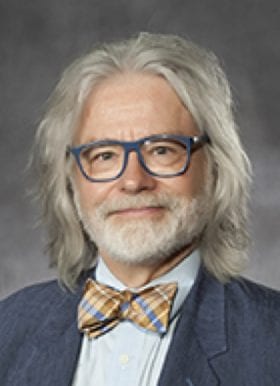
Jeffrey F. Williamson, PhD, MD(hon), FAAPM, FACR, FASTRO
Professor of Radiation Oncology
- Phone: 804-387-2512
- Email: jfwilliamson@nospam.wustl.edu
Education
- BA, Physics, Philosophy: St. Olaf College, Northfield, MN (1974)
- Philosophy of Science Graduate Program: Princeton University, Princeton, NJ (1976)
- MS, Biophysical Sciences: University of Minnesota, Minneapolis, MN (1980)
- PhD, Biophysical Sciences: University of Minnesota, Minneapolis, MN (1982)
Board Certifications
- Certified by the American Board of Radiology in Therapeutic Radiological Physics (1982)
- Certified by the American Board of Medical Physics in Radiation Oncology Physics (1990)
Recognition
- Fellowship (FAAPM): American Association of Physicists in Medicine (1996)
- Fellowship (FACR): American College of Radiology (2000)
- Honorary Doctor of Medicine degree: Linköping University, Linköping, Sweden (2004)
- Ullrich Henschke Award, American Brachytherapy Society (2006)
- VCU School of Medicine Research/Scholarship Recognition Award (2007)
- Fellowship (FASTRO): American Society for Therapeutic Radiation Oncology (2014)
- Editor-in-Chief: Medical Physics (2014 – present)
Biography
Jeffrey Williamson, PhD, MD(hon), FAAPM, FACR, FASTRO is a professor of radiation oncology, who joined the faculty at Washington University in 2016. He earned a master’s degree and PhD in Biophysical Sciences from University of Minnesota. He has been the chair of the medical physics division at both Virginia Commonwealth University (VCU) and the University of Arizona. In addition, Dr. Williamson previously held a faculty appointment at Washington University in the radiation oncology department where he solidified his national reputation as an innovative researcher in brachytherapy. Dr. Williamson has several National Institutes of Health (NIH)-funded projects in the physics of this modality and is currently looking at novel methods for using imaging technology to improve the planning and delivery of brachytherapy to patients. Dr. Williamson currently serves as the editor-in-chief for the journal Medical Physics.
Research
Dr. Williamson’s research is primarily related to improving radiation therapy clinical outcomes through innovative applications of medical imaging in order to more precisely delineate the cancerous tissue and more accurately target radiation dosage. One of his most ambitious projects involves the use of onboard and off-line 3D CT imaging combined with deformable image registration to improve radiation therapy targeting accuracy in the face of tissue motion and deformation due to setup error, normal physiological processes, and tumor regression. In addition, he is actively involved in research to improve the accuracy with which onboard cone-beam x-ray CT visualizes soft tissue structures; the development of CT techniques to quantitatively map the radiological properties of tissue composition inhomogeneities for improving proton-beam and low-energy brachytherapy dose-delivery accuracy; and developing more accurate brachytherapy dosimetry and dose-calculation tools. He uses a variety of engineering tools in his work, including iterative, maximum likelihood-based image reconstruction, automated feature extraction, finite-elements- and free-form deformable image registration, and hybrid Monte Carlo-deterministic radiation transport code design. His most important contribution to this field was the introduction, development, and validation of Monte Carlo photon transport simulations leading to acceptance of this methodology as an accurate and reliable computational dosimetry tool.
For nearly 15 years, Dr. Williamson has led a Washington University-VCU collaboration, including faculty from Washington University’s Electrical Engineering, Radiation Oncology, and Radiology Departments, that has successfully developed and experimentally implemented alternating minimization iterative image-reconstruction algorithms which have enabled the quantitative mapping of proton and low-energy photon cross sections in patients using commercially available CT platforms for the first time.
Publications
(Disclaimer: This listing may not include all articles associated with this faculty member and may include publications related to others with a similar name.)